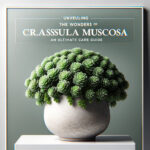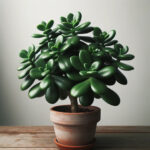Welcome to the exciting, intriguing world of Crassula alata! Known for its charm and relatively easy nature, this succulent makes for a gorgeous indoor plant addition. A distant cousin to the famous Jade plant, Crassula alata forms part of a large and diverse family of over 1,400 species! Now, let’s delve into the aromatic, dewdrop-laden world of Crassula alata – shall we?
When Green alights your windowsill
With a name derived from the Latin word ‘crassus’ translating to ‘thick’, Crassula alata gives a nod to its signature thick and fleshy leaves. Embellished with a glaucous green, speckled hue and adorned by delicately dainty flowers, this succulent plant is more than just eye candy – it’s a delight for the senses!
A slice of Crassula alata’s history and background
Crassula alata, also known as Winged Jade or Broad-Leaved Crassula, is native to South Africa. As a sub-tropical succulent, it is accustomed to dry conditions and rock crevasses, making it a hearty, adaptable and resilient plant compared to its green counterparts. This simple, understated beauty wears a garland of small yellow flowers, usually during the colder months, earning it a special place amidst the winter bloomers.
A treasured friend among plant enthusiasts
Countless garden enthusiasts and plant hobbyists hold Crassula alata in high regard – and there’s a good reason for this! Known for its forgiving nature and knack for survival, it tolerates a fair share of gardeners’ errors and yet bounces back, radiant as ever. It’s no wonder Crassula alata enjoys a shining spot in the sunny world of succulents and indoor plant cultivation.
As your journey unfolds with this soft-spoken yet eye-grabbing plant, the intricate world of Crassula alata cultivation promises to be an enriching experience. Stay tuned, as we move from this introduction to a more focused look – discussing care, management, and cultivation techniques of this captivating succulent!
Did you know that your beloved houseplant, Crassula alata, is a native of the sun-soaked climes of South Africa? The Crassula alata, a succulent visually distinctive with fleshy, spoon-like leaves, is truly an interesting member of the Crassulaceae family.
Tracing the Roots of Crassula alata
First, let’s dive into the geographical origins of the Crassula alata. The plant’s roots run deep in the context of Africa’s vegetation history. Originating from South Africa, it has adapted beautifully to the region’s soil and climate, making it tolerant to a range of conditions.
The Crassula alata usually thrives in rocky terrain and dry places with well-drained soil. Its evergreen nature allows it to withstand varied weather conditions. It’s a real survivor, just like the hardy people of its native land!
The Crassula alata’s Place in the Crassulaceae Family Tree
The Crassula alata hails from the captivating Crassulaceae family, known for its diverse set of members estimated to be more than 1,300-strong. This family has a globally widespread presence, although the majority of species including the Crassula alata, hail from the Northern Hemisphere.
This family brims with a variety of textures, shapes, and sizes of plants from the thick, chunky Sedum family’s ‘Hens and Chicks’, to fine, delicate vines like the Ceropegia woodii or ‘String of Hearts’. Yes, it’s a family that truly celebrates diversity!
Other Popular Members of the Crassulaceae Family
While Crassula alata is a darling of many plant owners, it’s worth noting that it shares its lineage with several other popular succulents. The glorious jade plant (Crassula ovata), for instance, is a close cousin characterized by glossy, green leaves and white or pink flowers.
Crassula perforata, or the ‘String of Buttons’, is another family member that’s beloved for decorative purposes, with leaves arranged in spiraling columns. Together with our Crassula alata, these plants make the Crassulaceae family a truly mesmerizing group of succulents.
So, there you have it – the rich background of the Crassula alata. Knowing about its history, geographical origin, and its fascinating relatives can not only make your caretaking journey more informed, but also helps you appreciate our cute little ‘Crassulas’ more.
Let’s dive right in and gaze at the physical beauty of the Crassula alata in all its resplendent glory! This marvel of Mother Nature is something you’ll fall in love with at first sight!
Size and Colour of Crassula alata
Primarily dwelling in the semi-arid regions of Africa, the Crassula alata is not the tallest member of its diverse family! Standing only about 1 to 2 feet tall when fully grown, this humble plant nonetheless stands out with its unique aesthetics. Its leaves are a gorgeous tone of green, ranging from a bright electric to a peaceful pastel, depending on the specific lighting conditions. This colour contrast gives the Crassula alata a unique place among houseplants.
The Formidable Foliage
The Crassula alata has leaves that are firm to the touch, a testament to their succulent nature. They are elegantly shaped with a somewhat elongated oval design, a good 2 inches long and about an inch wide. What makes them truly captivating is the incredible texture, like an artist’s landscape meticulously etched by the hand of nature. They’re covered in a protective layer of farina, giving them a silvery hue that shimmers when the light hits just right.
The Crassula alata Flowers
Who can forget the stunning blossoms of the Crassula alata! When this plant decides to show off its best outfit, it truly goes all out. The flowers are a striking shade of white or pale pink, with tiny specks of crimson or purple. Each tiny bloom positions itself like a star in the night sky, clustering together to form a breathtaking constellation-like spectacle. Truly, these floral delights are wonders to behold and truly distinguish the Crassula alata from its kin.
Comparing Different Crassula Species
Sure, the Crassula alata is part of the larger Crassula family, but it must be said that it proudly marches to the beat of its own drum. Unlike the more common jade plant or Crassula ovata, the Crassula alata has a more compact growth habit, making it perfect for small pot cultivation. Its leaf texture is also noticeably different from that of the Crassula perfoliata or propeller plant, which flaunts smooth and glossy leaves. Indeed, each Crassula comes with its own charm, but our Crassula alata certainly brings a unique vibe to the family portrait.
So there you have it, a glimpse into the sheer physical allure of the Crassula alata, the ultimate low-maintenance hero for your plant collection. From its stunning leaves to its spectacular flowers, every aspect of this plant cries out for appreciation. It’s not just a plant, it’s a conversation starter in any setting!
Let me introduce you to an amazing plant that may seem complicated at first but it’s not! Meet the Crassula alata. Known for its spectacular structure and striking leaves, this little powerhouse of the Crassula family has quite specific requirements when it comes to its livelyhood. However, once you get the hang of it, your Crassula alata will flourish and you’d love this journey.
The Ideal Climate for Crassula alata
Crassula alata hails from South Africa, a region known for its warm temperatures, moderate rainfall, and of course, stunning landscapes. This little fact informs us what the Crassula alata is used to and what it appreciates. Just like its cousins in the Crassula family, such as the Crassula ovata (also known as the jade plant), alata need a warm, dry climate, which is to say it doesn’t do well under wet or cold conditions. So, if you’re living in an area with long winters or frequent rainfall, it might just be best to keep your Crassula alata indoors.
Temperature Requirements for Crassula alata
This is where things get interesting. Unlike other succulent plants, Crassula alata isn’t a fan of steamy climates. Instead, it thrives best in day temperatures around 65-75°F (18-24°C), and at night, it can handle drops to around 50°F (10°C). So, it’s a good idea to pay close attention to the weather report. While other members of the Crassula family may shiver or wilt under such conditions, your alata will be cheerfully robust.
Lighting Conditions
No surprise here. Crassula alata loves sunlight, lots and lots of it. You want to guarantee it receives at least 6 hours of sunlight a day, ideally in the morning. However, it doesn’t necessarily need scorching sun rays. Direct, harsh sunlight can actually scorch the leaves. So, a bright, indirect light situation is perfect. This is one of the ways it contrasts to some of its siblings, like the Buddha’s Temple which actually prefers shadier spots.
The Perfect Soil for Crassula alata
When it comes to soil, Crassula alata is quite particular. It prefers a well-draining, gritty mix. It isn’t a fan of damp feet or waterlogged roots, so your best bet is a cactus or succulent mix. This is a common requirement in the Crassula family, as most of these plants are adapted to poor, fast draining soils. But remember, just like people, each Crassula has its own unique requirements and personalities.
Understanding the unique and intriguing conditions needed for Crassula alata’s growth will not only help you better take care of this lovely plant, but also get you more intimate with Mother Nature. Next time you see a Crassula alata, you’ll be able to appreciate the adaptation and strength that each leaf holds and the journey it took to get there.
Unraveling the Best Care Practices for Crassula alata
There’s something supremely satisfying about owning and nurturing a Crassula alata—you
literally watch life thrive in your hands! To maintain the plant’s overall health and survival, it’s crucial to grasp all aspects of its care. Let’s dive into the steps to guide you through this journey.
Watering Your Crassula alata
Water is the lifeblood of all plants, but be careful, too much of a good thing can be harmful. For Crassula alata, the “soak and dry” method works best. This simply means you drench the plant’s soil entirely with water and then wait until it’s completely dry before watering again. Like that time you ate too much chocolate at once and decided to wait a while before having more, you know? Similarly, your plant enjoys measured indulgences.
However, your Crassula alata’s watering needs will fluctuate with the changing seasons. During summer, when the sun is wearing its brightest hat, your Crassula alata might get thirsty more often. But come winter, you’ll want to ease up as the plant goes into a dormancy period – think of it like the plant’s cosy hibernation. As a general rule, always check that the top inch of soil is dry before next watering.
Repotting Your Vibrant Friend
Just like humans, Crassula alata also yearns for a ‘bigger home’ over time. The fixtures may need updates as the drainage system (its roots) grows and the family (new shoots) expands. So, these plants might hit you up for a move every two or three years. It’s crucially important to choose a pot that’s appropriate in size and has a proper drainage system. Poor Dwayne learned this the hard way when he potted his plant in a large container with poor drainage – he ended up with a severely waterlogged Crassula alata!
Serving All-Round Care to Crassula alata
Overall, Crassula alata care necessitates a balance of proper lighting, temperature, and pest control. Your plant loves basking in the morning sun but prefers to avoid harsh afternoon rays. Temperature-wise, it’s a fan of the mild, happy medium, with 65-75°F (18-24°C) being the sweet spot.
And remember, you’re not the only one who finds Crassula alata attractive—pests do too! Stay vigilant for common invaders like mealybugs and spider mites. A regular inspection schedule will keep these unwanted guests at bay and maintain a healthy Crassula alata.
With these comprehensive care guidelines, watering regime, and repotting tips, your Crassula alata will thrive and keep your space lively and refreshing. So, make room in your heart and your home for this delightful gem!
Uh-oh! Is your once-stunning Crassula alata looking a little under the weather? It might be facing issues that are common to this succulent. But hey, don’t worry! We’re here to crack the code and get your Crassula alata shining again. So, let’s get straight into it.
The Dreaded Pest Infestation
Are you noticing unwanted critters making a feast of your Crassula alata? Darn those pests! Common offenders typically include mealybugs, spider mites, and aphids. Sometimes, you may even notice tiny, little flies called fungus gnats. They’re all attracted to the succulent goodness of your Crassula alata and can pose a threat to its vibrancy and health.
So, what do you do? You fight back! Use an insecticidal soap or a solution of mild dish soap with water to clean your plant thoroughly. Ensure good ventilation afterwards to prevent any fungal growth. Regular inspections are also key! Remember, a proactive approach is better than firefighting after an infestation ensues.
The Overwatering Conundrum
Did you know that your Crassula alata is a bit of a dry spell champion? Like most succulents, our Crassula alata thrives in dry conditions, and overwatering could spell doom for it. You might notice that your plant becomes too soft and discolored, a surefire sign that you might be loving it a bit too much (yes, there is such a thing!).
Here’s the trick: water your Crassula alata only when the soil is completely dry. Always check if the top inch of the soil is dry before you reach for that watering can. Drainage is also crucial to prevent water from stagnating around the roots, which could lead to root rot. So, ready to take a relax-back approach to watering? Your Crassula alata will thank you for it!
The Temperature Teaser
Now, your Crassula alata isn’t a fan of temperature extremes. If you are witnessing leaf discoloration or dropping, your hostage may be subjecting it to either very cold or very hot conditions. It’s a plant that thrives in mild temperatures – think 70 to 75 degrees Fahrenheit during the day and a slightly cooler 50 to 55 degrees Fahrenheit at night.
Your action plan? Find a spot where the plant isn’t exposed to drastic temperature fluctuations or directly under an air conditioning vent. You can also try to tweak your indoor temperature to fit the needs of your Crassula alata. It’s all about finding that sweet spot, really!
So, now that you’re armed with these common issues and solutions, you and your Crassula alata are set for a thriving journey together. Remember, the key is observation, patience, and consistency. Bon, voyage!
Now, let’s navigate the exciting world of propagating your own Crassula alata! For those green-thumbers yearning to expand their succulent family, propagation is an affordable and sustainable alternative to buying new plants. Let’s, then, venture down the path of ‘From Leaf to Life’ with our Crassula alata.
Understanding Crassula alata Propagation
Propagation is the process of producing a new plant from the parts of an existing one. In the case of Crassula alata – or ‘Wing-Leaf Crassula,’ as it is commonly known – this can be achieved through the leaves or stem cuttings. Intriguing, isn’t it?
When to Propagate Crassula alata?
The right timing is crucial to successfully propagate a Crassula alata. The best period to start this process is during the growing season, specifically, during the late spring to early summer months. Keep in mind, your Crassula alata needs to be strong and healthy before you take any cuttings. That way, you’re giving your new plant the best possible start in life!
How to Propagate Crassula alata?
Now that you know when, let’s focus on the how. First, you must carefully select a healthy, mature leaf or stem from your Crassula alata. With a clean, sharp knife or pair of scissors, make a clean cut. Allow this cutting to dry, or ‘callous,’ for a few days. This drying out process is crucial to prevent infection and rot in your new plant.
The Magic Begins: Planting your Crassula alata Cutting
Once the cutting has calloused sufficiently, plant it in a well-draining soil mix, preferably one designed specifically for succulents. Initially, water sparingly to avoid overwatering and only when the soil has completely dried out. This mimics Crassula alata’s natural, arid habitat, initiating root growth. Remember, patience is key while cultivating Crassula alata cuttings.
Nurturing your New Crassula alata
Once your cutting has established roots and started to grow, continue to care for it just like you would an adult Crassula alata. Regular but moderate watering, plenty of sunlight, and well-draining soil are crucial to your new plant’s growth and survival. In no time, you’ll see your propagated Crassula alata taking shape, ready to augment the aesthetics of your green corner!
Little efforts with Big Rewards
Propagating Crassula alata, like growing any plant, is a process that requires some effort but yields substantial rewards. The joy of witnessing a plant you’ve propagated from a leaf or a stem cutting grow into a beautiful, mature plant is unparalleled. So, let’s relish this journey of nurturing life from the leaf with our captivating Crassula alata!
Marvelous Benefits of Growing Crassula Alata
If you’re seeking an excellent indoor plant that not only adds charm to your home but also purifies the air, meet your new green buddy, Crassula alata. This succulent comes packed with numerous benefits, from its delightful aesthetics to its air-cleaning abilities. It truly is an embodiment of beauty and functionality.
Crassula Alata – Your Personal Houseplant Air Purifier
Many houseplants claim to cleanse the air around us, but research shows that Crassula alata is no gimmick. It efficiently filters out airborne toxins and releases fresh oxygen, making your indoor environment healthier. Picture those long Southern summer afternoons, with your Crassula alata busily pumping out pure air while you relax. Logically, having multiple Crassulas in different parts of your home would mean more air purification and fresh, clean air to breathe. So, not only does this attractive plant create an appealing living space with its unique aesthetic, but it also silently works to improve your health.
Ornamental Uses of Crassula Alata
The Crassula alata isn’t just great for air quality; it’s also a stunner in the looks department! With its distinct green serrated leaves and feathery white flowers that bloom in winter, it adds an exquisite touch of greenery and vibrancy to any living space. They’re easy to care for, robust and very adaptable, so you can experiment with where you want to place them. Picture a Crassula alata gracing your kitchen window sill or your office desk, its bright green leaves and unique shape adding a dash of natural beauty.
Cultural Significance of Crassula Alata
Interestingly, beyond its obvious beauty and health benefits, Crassula alata has also found a unique place in certain cultures. For example, in Asian tradition, omens play a significant role, and Crassula alata is believed to bring good luck. Hence, you’ll often find it adorning business offices and homes alike. It is sometimes called the “money tree” or “lucky plant”, due to this belief in its potential to attract wealth and prosperity.
In summary, nurturing a Crassula alata reaps many benefits. It’s not only easy to grow and care for, but also visually appealing, a hardy air purifier, and according to some, a harbinger of good fortune. So why not add a handful of these wonderful plants to your living space?
Frequently Asked Questions
When it comes to Crassula alata care and cultivation, there are several common queries we come across. Here, we’ll touch upon the most often-asked questions we stumble upon. Stick around, you might find the answer to a question you didn’t even know you had!
How often should Crassula alata be watered?
A common question, and for good reason. Just like you don’t like to be soaked in lots of water, neither does your Crassula alata. During the peak growing season (spring and summer), you should water it ideally once the soil has completely dried out from the last watering. Think of it like waiting for your favorite cotton t-shirt to dry on a hot summer’s day – that’s how dry your Crassula’s soil should be before the next watering!
What is the ideal temperature for Crassula alata?
So, you’re wondering about the “happy place” for your beloved Crassula alata? Well, these succulents prefer pretty mild temperatures. During spring and summer, they thrive best in temperatures between 70°F to 80°F. In winter, try to keep them in an environment where the temperature doesn’t drop below 50°F. Remember, it’s all about balance, just like that hot cocoa in the winter that’s not too hot, not too cold, but just right!
My Crassula alata is not flowering. What can I do?
Don’t lose heart if your Crassula alata is not bursting into bloom. There could be several reasons for this. Ensure it’s getting plenty of light – they love to soak up the sun, just like a beach-goer lapping up those rays for a nice tan. Also, make sure you aren’t overwatering and maintaining the right temperature. If you’ve ticked off all these boxes, try being patient – sometimes your Crassula just likes to keep you waiting!
There you have it, a quick and easy guide to some of the most frequently asked questions about Crassula alata. Remember, patience and attentiveness go a long way in ensuring your plant thrives. So, stay curious and keep those green thumbs ready – your Crassula alata will thank you!



